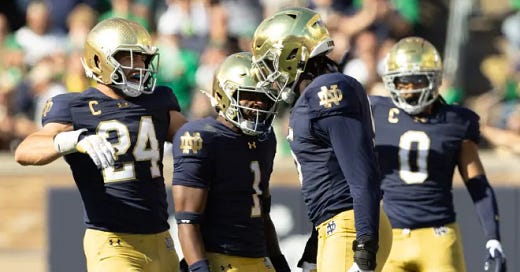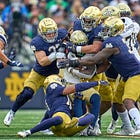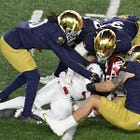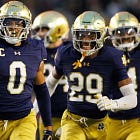Notre Dame leaned heavily on Cover 1 in the 2024 season, so it’s no surprise they paired it with a variety of pressures to keep offenses guessing. While simulated pressures weren’t their bread and butter, the Irish had them locked and loaded when needed. In this article, we’ll break down how Notre Dame mixed Cover 1 with simulated pressures and creepers, and then we’ll touch on how they used zone coverage as a curveball against the run.
As always, I’ll be using my terminology for these concepts. You might call them something else, and that’s just fine. Adjust as needed.
Bears 1 Rat
This simulated pressure is a staple for good reason, it’s a perfect way to attack half-slide protection while remaining flexible with your coverage. Whether you’re in Cover 1, 2, 3, or 4, Bears 1 Rat can fit seamlessly into your game plan.
The key to its success is the two edge players sharing responsibility for the running back and the “Rat” defender. In this look, #24 becomes the “Rat,” presenting just enough of a threat to keep the quarterback from confidently hitting his first read on the mesh. Even though the receiver gains separation across the formation, the QB hesitates, and that’s all the defense needs.
Mahomes 1 Rat
Mahomes shares a lot of DNA with Bears 1 Rat, especially with both edge players dropping out. The main difference? Presentation. This one comes from a 4-down front, giving it a more traditional, balanced look.
That even alignment makes it easy for the droppers to split responsibilities, one taking the running back and the other serving as the “Rat.” It’s clean, simple, and forces the quarterback to think twice. And as we know, hesitation is a defensive coordinator’s best friend.
Stafford 1 Rat
In this look, Notre Dame dials up what I call Stafford. At first glance, it looks like a 5-man pressure, but the edge player is “hug rushing” the back, meaning he’s responsible for him in coverage if he releases.
The beauty of this variation is how the Irish use a Boss front with a walked-up linebacker, which creates confusion in protection. It’s a great example making a simple path feel complicated for the offense. By forcing the protection to account for extra bodies on one side on the line, and bringing pressure from the other the Irish get a plus one advantage.
Zone Coverage Change Up
While Cover 1 was Notre Dame’s bread and butter, they weren’t afraid to mix in some zone coverage. Pairing these pressures with zone looks gave them an added layer of unpredictability, making it harder for quarterbacks to get a clean pre-snap read.
It’s a smart way to keep offenses honest, just when they think they’ve got a man-beater dialed up, they’re throwing into zone eyes. And that’s when bad decisions happen.
This one’s a classic creeper, with the Mike working the strong-side B gap. We’ve always called it Tebow, but like I’ve said before, call it whatever fits your system.
Notre Dame paired this with a strong rotation Cover 3, keeping things simple both up front and on the back end. It’s a straightforward pressure, matched with an easy coverage.
In this final rep, Notre Dame goes back to the Bears path, but this time they pair it with a Non-Traditional Tampa (NTT) look. Indiana manages to complete the pass, but that’s more on the hole runner getting a bit too deep than any fault with the concept itself.
Notre Dame’s defense in 2024 wasn’t built on endless complexity. Instead, they relied on sound schemes, greatc technique, and relentless effort, a formula that carried them all the way to the CFB Playoff Championship.
They weren’t always the flashiest unit on the field, but when the moment called for it, they had answers. Schemes like these simulated pressures and creepers were ready to create confusion and force mistakes. It’s proof that sometimes, doing the simple things at an elite level is what makes a championship defense.








